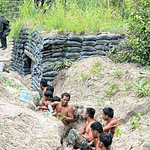Divergent strategies on border disputes could be solved with an ASEAN solution. But is there the political will?
The fighting along the Cambodia–Thailand border in July 2025 was short-lived but very telling. More than 140,000 people were forced to leave their homes due to five days of artillery fire and skirmishes. More than 1,200 schools were closed, and $5 billion in cross-border trade was frozen. Almost as important as the casualties and disruptions themselves, however, is what they reveal: the weakness of Southeast Asia’s border management, the exacerbating effects of domestic politics, and the limitations of the Association of Southeast Asian Nations’ (ASEAN) conflict-prevention system.
Domestic politics as the trigger
The clashes at Preah Vihear and at other temples were driven by political unrest and didn’t have to happen. Governments with military or royalist ties have used border disputes for a long time as symbols of national security and loyalty to the monarchy. The suspension and later firing of Thai Prime Minister Paetongtarn Shinawatra after a leaked phone call with former Cambodian leader Hun Sen left a gap in leadership that nationalist groups quickly exploited. The escalation had less to do with the border and more to do with problems in Bangkok.
Cambodia, on the other hand, took a defensive military stance but a strategically intelligent political one. Phnom Penh used the crisis to garner sympathy domestically and around the world. Cambodia’s Hun Manet, who is still trying to establish his authority after taking over from his father, Hun Sen, took advantage of the situation to gain the public’s trust as a steady hand during the standoff. The unevenness in approaches reveals a larger lesson: in Southeast Asia, the political landscape in national capitals has a greater impact on border crises than does geography.
Preah Vihear: an old wound
The Preah Vihear temple sits on a cliff that divides two countries whose borders were drawn during the colonial period. The International Court of Justice made a clear decision in favour of Cambodia’s claim to the territory in 1962. But Thailand has never fully accepted the ruling. For decades, this unfinished business has made it easier for nationalists to attract people to their cause.
ASEAN’s way of doing diplomacy, which involves consultation, dialogue, and step-by-step negotiation, has helped keep past disagreements from getting out of hand. But the clashes in July show that it has limits. Without strong oversight or enforcement, agreements are at the mercy of politics at home. When nationalism is at its highest, the guardrails come off.
The costs of reactive policy
The humanitarian fallout showed how much Southeast Asia still depends on ad hoc responses. Evacuations in both countries put immense pressure on border provinces, and aid groups such as UNICEF and World Vision rushed to provide food, shelter, and mental health support. Ongoing security risks meant humanitarian access was patchy, and schools in both Cambodia and Thailand lost important days of teaching. The damage to their economies was just as bad. Border closures stopped a trade relationship worth billions of dollars, showing how these communities are acutely vulnerable.
What ASEAN must fix
The message to ASEAN policymakers is clear: waiting until a crisis occurs costs money and lives. Humanitarian protection needs to be considered from the start, not just as an add-on. A regional rapid-response system should include supplies that are already in place, mobile field hospitals, and protections for vulnerable groups such as children, women, and people with disabilities.
Also important is better monitoring and verification. Independent observer teams sent by the ASEAN Chair would make ceasefires more robust. New technologies, such as satellite imagery and open-source reporting, could help fill the gaps in information and lower the level of distrust that often leads to escalation.
Politics shouldn’t get in the way of technical demarcation either. Rivalries between Bangkok and Phnom Penh shouldn’t determine if a surveyor can put up a border marker. Putting neutral ASEAN chairs in charge of the process and starting with less controversial parts of the border would build trust and keep nationalists from stoking division.
Cultural exchanges and shared development projects can make zero-sum nationalism less appealing.
Investing in civic peacebuilding would also be key to the process. Cultural exchanges and shared development projects can make zero-sum nationalism less appealing. If Preah Vihear were marketed as a shared heritage site with mutual-access tourism, it would represent common ground instead of disputed sovereignty. Lumbini, the birthplace of Buddha, showcases how contentious locations can be transformed into communal cultural resources, fostering collaboration, tourism, and interpersonal connections, rather than competition.
From fire-fighting to risk management
The fighting at Preah Vihear and in other border areas lasted less than a week, but the lessons will last a lot longer. Thailand’s internal politics caused the clashes, and ASEAN’s weak institutions made them worse. Border disputes will keep costing money and lives unless the region stops using reactive diplomacy and nationalist grandstanding.
Southeast Asia already has the policy framework it needs to do better. But it doesn’t have the political will to use it.
This article was originally published in The Lowy Institute. It is republished here with proper attribution. You can read the original version: https://www.lowyinstitute.org/the-interpreter/five-days-fire-lessons-cambodia-thailand-border-crisis






